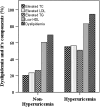Investigating the Relationship Between Serum Uric Acid and Dyslipidemia in Young Adults in Bangladesh
- PMID: 40420797
- PMCID: PMC12107107
- DOI: 10.1002/edm2.70063
Investigating the Relationship Between Serum Uric Acid and Dyslipidemia in Young Adults in Bangladesh
Abstract
Objectives: While some reports exist on the relationship between serum uric acid (SUA) and dyslipidemia in adults, there is limited information available regarding young adults. This study aimed to evaluate the relationship between SUA and dyslipidemia, as well as its components, among young adults in Bangladesh.
Methods: This study consisted of 458 participants (281 male and 177 female) aged between 18 and 30 years. The levels of SUA, fasting blood glucose and lipid profile (TG, TC, HDL-C and LDL-C) were measured using standard colorimetric methods. Bivariate logistic regression modelling was used to examine the relationship between SUA and dyslipidemia and its components.
Results: The overall prevalence of hyperuricemia was 24% with 27.6% in males and 18.6% in females. Males had a higher mean SUA level (6.6 ± 1.5 mg/dL) than females (5.3 ± 1.2 mg/dL) (p < 0.001). The prevalence of dyslipidemia was 74.2% with 83.2% in male and 59.8% in female subjects. The prevalence of hypertriglyceridemia, hypercholesterolemia, high LDL-C and low HDL-C was 30.1%, 26.2%, 28.8% and 64.8%, respectively. There was an increasing trend in the level and prevalence of elevated lipid profile markers across the SUA quartiles (p < 0.001). SUA level showed a positive correlation with TG, TC and LDL-C and a negative correlation with HDL (p < 0.001). In regression analysis, a significant association was found between SUA and dyslipidemia in all participants as well as in the male-female groups separately (at least p < 0.05). Furthermore, a significant association (p < 0.001) was found between SUA and individual lipid components in the regression models.
Conclusion: Dyslipidemia and its components were more prevalent in individuals with hyperuricemia than in those without. This study identified a significant association between SUA and dyslipidemia in young adults in Bangladesh. Further research is needed to explore the mechanisms behind this association.
Keywords: Bangladesh; cardiovascular disease; dyslipidemia; serum uric acid; young adults.
© 2025 The Author(s). Endocrinology, Diabetes & Metabolism published by John Wiley & Sons Ltd.
Conflict of interest statement
The authors declare no conflicts of interest.
Figures



References
-
- Schlesinger N., “Dietary Factors and Hyperuricaemia,” Current Pharmaceutical Design 11 (2005): 4133–4138. - PubMed
-
- Terkeltaub R. A., “Gout,” New England Journal of Medicine 349 (2003): 1647–1655. - PubMed
-
- Luk A. J. and Simkin P. A., “Epidemiology of Hyperuricemia and Gout,” American Journal of Managed Care 11, no. 15 Suppl (2005): S435–S442. - PubMed
-
- Borghi C., Rosei E. A., Bardin T., et al., “Serum Uric Acid and the Risk of Cardiovascular and Renal Disease,” Journal of Hypertension 33 (2015): 1729–1741. - PubMed
MeSH terms
Substances
LinkOut - more resources
Full Text Sources
Miscellaneous

